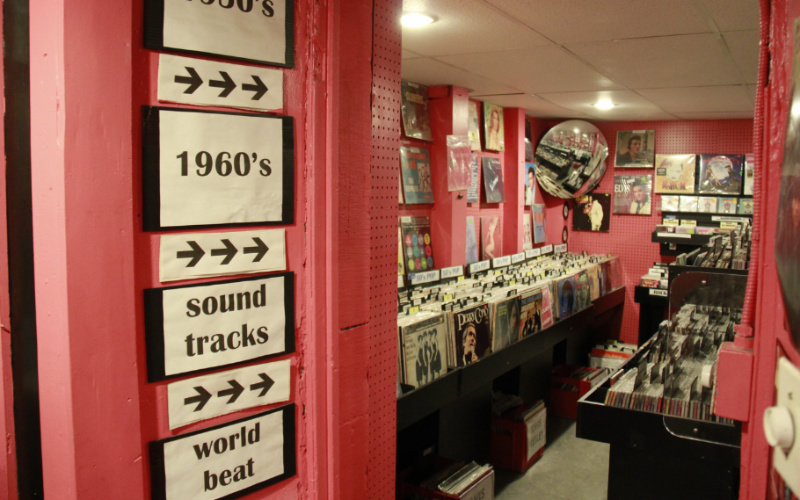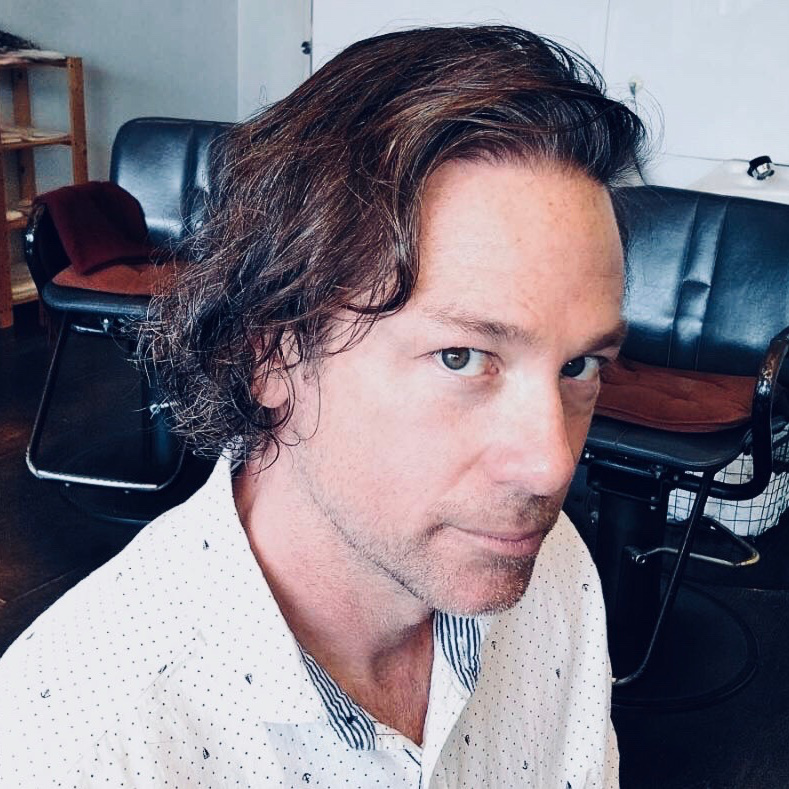The Gunk Degreaser
Jason Emde

Excerpt from The Gunk Degreaser:
The Gunk Degreaser: October 21, 1969
§
Jack Kerouac is going to die in St. Petersburg, Florida, and he knows it. His drinking is massively out of control: a quart of whiskey a day, with beer chasers, what Jack calls “a shot and a wash.” Angry, bloated, herniated, diminished, disenchanted, lonely, lost, the once-celebrated author of On the Road and some twenty other books is killing himself very slowly in an insistently average concrete block house at 5169 10th Avenue, where he lives with his wife and paralyzed mother. Salvador Dali once said that Kerouac was more beautiful than Marlon Brando but the lushing and bar fights have seen to that. His conversation is rebarbative: he likes to bitch about Jews and Communists. He sits in his Early American rocking chair and sips whiskey out of a pill bottle. He paints popes and crucifixes. According to his doctor his liver is almost gone. He is 47 years old.
October 20th. He has tuna for breakfast and sits in his chair to make notes for a new novel, The Spotlight Print. The name is borrowed from his late father’s long-ago printing shop. What visions? What father-and-son stuff? What pain? “Stories of the past,” he recently told a journalist. “My story is endless.” His wife hears something, gets up, and finds him on his knees in the bathroom, vomiting blood. “Stella, I hurt,” he says, as he’s ambulanced away—his first complaint to his last wife.
Death’s phantom hand, unstayed. Twenty-six transfusions, almost 30 pints of blood. At 5:30 in the morning of the 21st, the self-described “catatonic Buddha” dies of hemorrhaging esophageal varices. He is finally, as he longed to be, safe in heaven dead. Walter Cronkite makes the inevitable reference when he says, “Jack Kerouac, author of On the Road, reached the end of it today.”
Unsung in St. Petersburg. Is there sombre drinking in the Flamingo? In the Collage? In the Cactus Bar? No waitresses weep at Farmer John’s Chicken ’N Roast Beef (“Excitingly New & Different”). Farmer John’s newspaper ad this days claims that “‘A Chicken Ain’t Nuthin’ But A Bird’ and We Got One That Talks! Really Talks!” The chicken’s name is Jack. Is this a sign? No clerks cry while stocking shelves in the hardware store with Gunk Degreaser, 59¢ a quart. Jack claimed that the beat in beat generation meant beatific. He wrote that “…there was embedded in my believing tho confused head a belief that life was holy, that I should write about it pointing out the holiness throughout the squalor and commonplaceness, that the very streets of life were holy…” Slaves rowing to the beat, the beat of a universal drum, beatitude. By 1969, however, Kerouac’s visions are no longer fashionable. The big book so far this year is Jacqueline Susann’s The Love Machine, a kitschy potboiler about socialites and supermodels and TV: “She walked down to the river and knew the tears were running down her face. Oh, God, it wasn’t fair to put the heart and emotions of a beautiful woman into the body of a peasant.” The mood of the times.
A year before his death Kerouac went on William F. Buckley’s Firing Line, floridly shitfaced, and said, “I believe in order, tenderness, and piety.” He also claimed he’d recently been arrested “for decay” and that the war in Vietnam was simply a plot between the North and the South —“who are cousins”—to get jeeps in the country. “They’re not very good plotters, are they,” murmured a bemused Buckley. “But they got a lot of jeeps!” replied Kerouac, wide-eyed.
§
Playboy, October-November, 1969:
Jac-slacs are cut out for your kind of groove. Very cool. Very masculine.
What sort of man reads Playboy? A young man in high gear. He seeks out the strikingly new naturally. Whether he’s selecting his personal attire, a pretty companion or the car of tomorrow today, he’s the one to watch.
I know men. And I like men. But some are more persuasive than others. I think the way they smell has a lot to do with it.
You should slap my face for what I’ve been thinking about you.
Now there’s a new movement in luxury apartment living completely built around the restless, demanding young breed. The apartments, the furnishings, the pools, sauna, maid and valet service fit your way of living—and so does the action, scheduled and unscheduled, the worldwide travel clubs, the with-it management philosophy.
Introducing the first imported boots made in America.
§
People are dying in their tens of thousands in Vietnam and the radical left in Japan know all about it and think it’s bullshit. On what they’ve labeled “International Antiwar Day,” Tuesday, October 21st, some 19 000 “guerillas”—distinctly non-hippy-looking, steel-pipe-wielding, rock-tossing student activists—riot in Tokyo, smashing windows, overturning cars, and lobbing gasoline bombs at businesses, police boxes, movie theatres, train stations, and trains. Action, scheduled and unscheduled, flares across the city. The city centre is brought to a standstill; schools close; shops and government offices send their employees home and shutter up so as to “avoid trouble.” But the riots are just a warm-up: demonstrations and rallies involving tens of thousands of people swarm through the streets; enormous crowds gather in Yoyogi Park to listen to anti-war speeches in the rain. The protesters’ grievances include the escalating carnage in Vietnam, the U.S.-Japan Security Treaty, and ongoing American possession of Okinawa. Seventy thousand riot police, all tear gas and nightsticks, are deployed nationwide. Violence breaks out in almost a hundred cities. Altogether, 1505 people are arrested, the highest recorded number for Japanese riots since the end of the Second World War. Eighty policemen are wounded, by pipes, rocks, and fire.
It’s been three years since the Beatles gave a series of concerts at the Nippon Budokan, a martial arts hall near Tokyo Station, the Imperial Palace, and Yasakuni Shrine, concerts that triggered protests by ultra-nationalists and right-wing students who believed songs about love would defile the purity of the hall and the virtue of Japanese youth. The mood of the times. Now an unusual silence settles over large parts of the world’s biggest city. Footsteps echo down empty boulevards. Apart from the occasional clattering roar of a passing helicopter, the ritzy Ginza area is surrealistically quiet. Waiters in the Lion Beer Hall shrug, wipe up, and go home.
The protests lodge in the heart of Mishima Yukio, Japan’s most acclaimed living writer. He’s a polarizing figure, regarded with suspicion for his seemingly retrograde militarism and “cosmic nihilism,” admired for his literary output. He writes every night, from midnight to dawn: novels, poems, plays, lectures, essays, short stories, songs. “Since World War II, the feminine tradition has been emphasized to the exclusion of the masculine,” he said. “I am trying to get back to the ‘rough-soul’ tradition of the samurai.” He will refer to the October 21st riots when he addresses Self-Defence Force soldiers from a balcony at Ichigaya Base in downtown Tokyo just over a year later, on the same day that he delivers his final novel, The Decay of the Angel, to his publishers. Members of his private army, the Shield Society, wearing sleek Mishima-designed uniforms, take General Mashita, the commander of the Eastern Army, hostage; he will be released only after Mishima has been allowed to speak to the troops. “On October 21st there was an anti-war demonstration,” he says, “which was put down by the police. I have waited since then for the Self-Defence Forces to act. You must rise! You must protect Japan!” It is hard to hear him; the assembled soldiers jeer. “If you do not rise with me, you will just be American mercenaries! American troops!” “Let the General go! Fucking idiot!” the scandalized soldiers yell. His coup a failure, Japan doomed to servitude and weakness, Mishima goes inside and disembowels himself. After several bungling strokes, one of his minions cuts off his head with a sword.
“Absentmindedness leads to great wars,” Kerouac said. “Try to remember that.”
§
Playboy, October-November, 1969:
Our Beautiful Singles Tour is designed for people who want more than just sightseeing to look forward to on their trip to London: Computer-arranged dates with 3 single Londoners. A series of cocktail parties to meet them at. Admission to London’s top discotheques and dance halls. 2 weeks in a modern, first class hotel with private bath, breakfasts included. All for only $350.
Devastate your buddies with your awesome knowledge of high fidelity.
We made suede swing. Styled it upbeat and earthy. Tailored it soft and supple. Suede can do it for you.
That’s why men should ask Santa for Hai Karate After Shave and Cologne. Hai Karate really works. Sometimes too well. That’s why we include instructions on self-defense in every package.
Blow in her face and she’ll follow you anywhere.
Very masculine.
§
Paul McCartney isn’t dead and everybody knows it. For two months in the fall of 1969, however, a lot of people try to prove it’s true anyway.
In September, a gleefully speculative article—“Is Paul McCartney Dead?”—appears in the Drake University newspaper. Various so-called clues—apparently buried by the Beatles themselves— are floated. On October 12th, a student from Eastern Michigan University calls a Detroit FM station with additional clues, and a review of the Abbey Road album with exciting “new evidence” is published in the Michigan Daily. The story is picked up by newspapers across the US. On Tuesday, October 21st, a DJ at WABC New York discusses the story on-air for over an hour. He is heard in 38 states. There’s a lot to talk about.
During the fade-out in “Strawberry Fields Forever” John Lennon can be heard intoning, “I buried Paul.” On the Sgt Pepper Lonely Heart’s Club Band cover, Paul is wearing a patch that says OPD: Officially Pronounced Dead. There’s also a phantom hand floating over his head, a mystical Eastern symbol of death. If you hold the Magical Mystery Tour album upside-down or up to a mirror or up to a mirror upside-down or reflect it in the left eyeball of a fox terrier on psychotropic drugs you’ll see a phone number; call the number and get another clue, or talk to William Campbell, Paul’s replacement in the Beatles, or win a trip to Pepperland. In the Magical Mystery Tour booklet, John’s “I Am The Walrus” is subtitled “No You’re Not Said Little Nicola;” on the White Album track “Glass Onion” (which is, of course, old British slang for a casket handle—caskets that were usually made out of Norwegian wood) John sings, “Here’s another clue for you all: the walrus was Paul.” Walrus, of course, means corpse in Greek. “Come Together,” the first song on the Beatles’s fall ’69 album, Abbey Road, begins with John susurrating “Shoot me.” Later in the song he sings that one and one and one is three: only three Beatles are still alive.
Abbey Road’s cover, meanwhile, is the Paul-Is-Dead jackpot. The front cover photo, taken on August 8th by Iain Macmillan, represents a funeral procession, with John as the priest, Ringo as the undertaker, George as the gravedigger, and Paul as the corpse—out of step with the others, smoking with the wrong hand, and barefoot, because that’s how they bury walruses in Italy. Behind him is a Volkswagen with a license plate reading 28 IF, meaning Paul would have been 28, if he hadn’t blown his mind out in a car and lost his hair and died. The fact that he would only have been 27 is deftly explained by the fact that, in some Asian countries, babies are traditionally considered a year old at birth, thanks to womb-time. On the back cover of the album is a skull made of sunlight.
Hours after the Beatles walk across Abbey Road to be photographed for the cover, members of Charles Manson’s so-called “family” butcher Sharon Tate and four others at the home of Roman Polanski on Cielo Drive in Los Angeles, California. Charlie believes the Beatles are sending him messages, encouraging him to start a race war in the United States. Tate, who had starred in the film version of Valley of the Dolls, based on Jacqueline Susann’s novel, is eight months pregnant.
On Tuesday, October 21st, the Beatles’ beleaguered press office, buffeted by blasts of morbid hot air and hassled by worried fans, issues a terse statement, calling the Paul-Is-Dead story “a load of old rubbish.” This fails to kill the rumour. Beatle album sales, never moribund, soar anew.
Tracked to his farm in Scotland by a team from Life magazine, Paul says, “Perhaps the rumour started because I haven’t been much in the press lately.” A November 7th cover story reads The Case of the ‘Missing’ Beatle — Paul is still with us. McCartney’s alive, but his band is dead. “The Beatle thing,” he says, “is over.”
Yoko Ono, Lennon’s wife, widely blamed for breaking the Beatles up with her mysterious Asian ways, says, “The story of the Golden Temple: A guy fell in love with it and burned it down. He couldn’t stand the idea of its falling apart as it got older, and now the Golden Temple exists in perfect form forever. It became a myth…That’s why the Beatles will stay a beautiful myth, because they ended before they deteriorated.”
§
Playboy, October-November, 1969:
Lead women around by the nose. Blended from 18 of the world’s most savory tobaccos. You’ll like it. Women love it.
Sure there are guys who keep girls in mink. They only have one girl to keep happy. But with more than one, it can be a little expensive. This year keep your girls in pantyhose.
Let the roast burn. Just for once, don’t be such a good wife. Take 15 minutes off and be a good girl.
You can use grease or hairspray or some other kind of gunk to hold it down. Or, you can consider our alternative. The REMINGTON HotComb. It runs on electricity, which produces hot air, which provides a comb-blower effect. Which makes a big difference.
I hate to bother you, but I just bet a fellow over there $25,000 that you’d come to dinner with me.
Very cool.
§
“He’s a ‘nobody’ to those who know him but he is now a ‘somebody’ because everybody knows he has killed five persons although they don’t know his identity,” says handwriting expert William Baker. On October 21st, ten days after The Zodiac murders San Francisco cab driver Paul Stine by shooting him in the head, the Examiner runs a story headlined Zodiac’s Graph: Impotent, Shrewd, Paranoid, which features Baker’s analysis of one of the killer’s mysterious ciphers. “The ‘Zodiac’ killer is probably impotent, is afraid of women and hates them,” says Baker, “but he’s no homosexual.”
This particular phantom has been haunting California for the past three years. Five victims officially pronounced dead. Known at first as the “Cipher Slayer” and the “Code Killer,” the murderer names himself in an August letter to the Examiner which begins, “This is the Zodiac speaking.”
“He feels suspended between heaven and hell,” Baker says. “The strong slant to the left of the lower letters denotes a ‘mother hostility’ and an unhappy childhood…you have a man who is capable of killing women to get even with his mother.”
Stine is the Zodiac’s first urban victim; until now he’s been content to shoot and stab couples in remote areas further north, in Solano and Napa counties. His most recent letter to the police, published on October 17th, unleashes panic throughout the entire Bay Area.
School children make nice targ-
ets, I think I shall wipe out
a school bus some morning. Just
shoot out the frunt tires & then
pick off the kiddies as they come
bouncing out.
From Candlestick Park—where three years earlier the Beatles played their final concert—to the old beatnik hang-outs centred around City Lights Books in North Beach, to the Presidio, to the holy commonplace squalor of Haight-Ashbury, to Japantown, to Russian Hill, San Francisco shudders in the fog. Dread is afoot.
If the
Blue Meannies are evere
going to catch me, they had
best get off their fat asses
& do something.
Further south, in Independence, Charles Manson—booked as “MANSON, CHARLES M., AKA JESUS CHRIST, GOD”—and members of his “family” sit in county lock-up after a series of raids on their grubby hideout at Barker Ranch, charged with arson and grand theft auto. Charlie and his gang of hippy misfits won’t be charged with the appalling murders on Cielo and Waverley Drives in Los Angeles the previous summer until December 9th, three days after the Hells Angels, wired on beer and acid and ultra-violence, stab a young black man to death during a free Rolling Stones concert at Altamont Speedway. In December, Life magazine will put Manson on the cover, with the headline “The Love and Terror Cult.” Rolling Stone will also put Manson on the cover, calling him “the most dangerous man alive.”
“Beauty, beautiful things,” Mishima wrote in The Temple of the Golden Pavilion, “those are now my most deadly enemies.”
Order, tenderness, and piety. Decaying angels. The mood of the times. Very masculine. Very cool.
No you’re not, said Little Nicola.
 Jason Emde is a writer, teacher, and amateur boxer from Vernon, British Columbia, Canada. His first book, “My Hand’s Tired & My Heart Aches: Letters from Japan 1995-2005,” was published by Kalamalka Press in 2005. In 2017, Jason began working on an MFA in Creative Writing through the University of British Columbia’s Optional Residency program. Jason and his wife, Maho, live in Gifu, Japan, with their sons, Joe and Sasha.
Jason Emde is a writer, teacher, and amateur boxer from Vernon, British Columbia, Canada. His first book, “My Hand’s Tired & My Heart Aches: Letters from Japan 1995-2005,” was published by Kalamalka Press in 2005. In 2017, Jason began working on an MFA in Creative Writing through the University of British Columbia’s Optional Residency program. Jason and his wife, Maho, live in Gifu, Japan, with their sons, Joe and Sasha.
Featured Image: “Beatnick 3770 St-Denis Montreal Canada (50s & 60s section, soundtracks, rockabilly)” provided by JFHayeur is licensed under Public Domain


No Comments